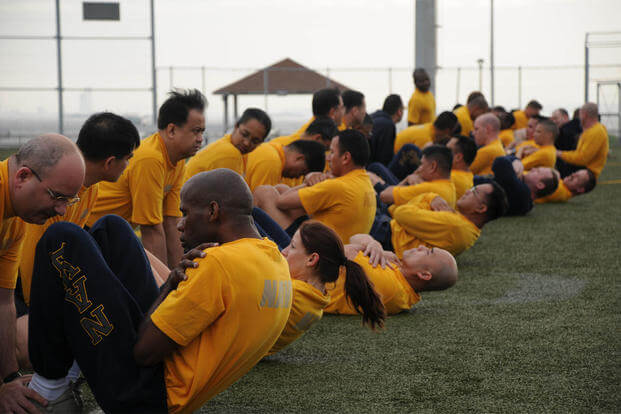Checking into a new command? Coming back from leave? Taking a urinalysis drug test?
Sailors in any of those situations are fair game for a "spot check" body composition assessment, according to new guidance released Wednesday by the Navy.
Three months after the Navy published updates to its physical fitness policy in an effort to emphasize health over a one-size-fits-all standard, it released additional guidance providing details on how to administer body composition assessments, and when and how to conduct BCA checks that are now part of what sailors can expect as standard procedure.
"A healthier and fitter force is created by more than just a twice-a-year test. This guidance helps establish a culture of fitness in the Navy and keeps Sailors on the best path for staying fit both now and in the future," said Rear Adm. Ann Burkhardt, director of the 21st Century Sailor Office, in a statement. "The goal of these changes is to achieve a healthier, fitter force with more Sailors taking the [physical readiness test] resulting in fewer failures and better mission readiness."
According to the new guidance, BCA spot checks are to be conducted at the discretion of the commanding officer. Spot check failures result in a sailor being assigned to the fitness enhancement program, or FEP, where he or she will be provided with nutritional counseling as well as additional opportunities to take and pass the BCA.
Commanders are recommended to administer spot checks to sailors under the following circumstances:
- Within five days of checking in to a new command
- When they return from extended leave or temporary additional duty
- On a "unit sweep" basis to identify sailors who are candidates for the FEP
- In conjunction with routine urinalysis tests
- For reserve personnel, after extended authorized absences
- As part of the "Division in the Spotlight" self-assessment program
- On the recommendation of a command fitness leader.
Officials emphasized that the policy updates that took effect Jan. 1 will require a sailor to leave the service after two BCA failures in three years, while the previous policy required separation only after three failures within four years.
"It is important that all hands stay proactive in achieving and maintaining the health and fitness goals of the Navy," the NAVADMIN stated.
The updates also provide specific directions on how to administer the BCA. Sailors now have multiple opportunities to pass the assessment. If they don’t clear the Navy’s current height and weight standards, they can submit to a single-site abdominal circumference measurement. The Navy requires sailors to measure within 39 inches for men or 35.5 inches for women. If a sailor measures outside that standard, he or she has one more opportunity to pass: the Defense Department "rope and choke" tape measure method.
The guidance released Wednesday also contained specific instructions for command fitness leaders on how to administer the abdominal circumference measurement for accurate results.
The CFL will begin the measurement above the right uppermost hip bone, the guidance states, at the side of the body vertically in line with the right armpit. The sailor being measured will stand with feet flat on the floor, unmoving. The measurement is taken, the guidance states, on bare skin "at the end of a sailor’s normal respiration."
Each measurement will be taken twice and rounded down to the nearest half-inch for accuracy.
All sailors will have a chance to pass the PRT, regardless if they pass the BCA, according to the policy updates. But any sailor who fails the BCA, or scores a probationary or failing score in any PRT event, will be assigned to the fitness enhancement program until they can meet standards.
-- Hope Hodge Seck can be reached at hope.seck@military.com. Follow her on Twitter at @HopeSeck.




























